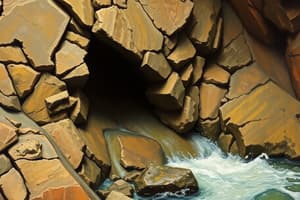Podcast
Questions and Answers
What are the main processes of metamorphism?
What are the main processes of metamorphism?
- Recrystallization, neomorphism, and metasomatism (correct)
- Fusion, sedimentation, and erosion
- Compression, expansion, and deposition
- Melting, crystallization, and lithification
What distinguishes foliated metamorphic rocks from nonfoliated metamorphic rocks?
What distinguishes foliated metamorphic rocks from nonfoliated metamorphic rocks?
- Foliated rocks originate from sedimentary rocks, nonfoliated from igneous rocks
- Foliated rocks are formed under low pressure, nonfoliated under high pressure
- Foliated rocks are always harder than nonfoliated rocks
- Foliated rocks have a striped or layered appearance while nonfoliated do not (correct)
In the rock cycle, which statement best describes how metamorphic rocks relate to other rock types?
In the rock cycle, which statement best describes how metamorphic rocks relate to other rock types?
- Metamorphic rocks can only form from sedimentary rocks.
- Metamorphic rocks cannot be converted back into igneous rocks.
- Metamorphic rocks are the final stage in the rock cycle.
- Metamorphic rocks can form from igneous, sedimentary, or other metamorphic rocks. (correct)
What is the primary difference between recrystallization and neomorphism in metamorphism?
What is the primary difference between recrystallization and neomorphism in metamorphism?
Which of the following factors contributes primarily to mechanical weathering?
Which of the following factors contributes primarily to mechanical weathering?
What defines neomorphism in the metamorphic process?
What defines neomorphism in the metamorphic process?
Which statement accurately describes foliation in metamorphic rocks?
Which statement accurately describes foliation in metamorphic rocks?
Which process is specifically associated with the introduction of heat and volume of fluids in contact metamorphism?
Which process is specifically associated with the introduction of heat and volume of fluids in contact metamorphism?
What distinguishes nonfoliated metamorphic rocks from foliated ones?
What distinguishes nonfoliated metamorphic rocks from foliated ones?
How can metamorphic rocks transform within the rock cycle?
How can metamorphic rocks transform within the rock cycle?
Flashcards are hidden until you start studying
Study Notes
Formation of Metamorphic Rock
- Metamorphic rocks are formed when pre-existing rocks undergo changes due to heat, pressure, or chemically active fluids without melting.
- Recrystallization converts small crystals of a mineral into fewer, larger crystals of the same mineral.
- Neomorphism involves recrystallizing minerals and forming new minerals from the same chemical elements.
- Metasomatism involves the addition or loss of chemical elements, resulting in new minerals from the original elements.
Types of Metamorphism
- Contact Metamorphism: Occurs in localized areas near large igneous intrusions and along fractures that come into contact with hot fluids.
- Regional Metamorphism: Occurs over larger areas due to intense pressure and heat, typically associated with deep burial and major igneous intrusions.
Classification of Metamorphic Rocks
- Foliated Metamorphic Rocks: Characterized by parallel planes of platy or elongated minerals, leading to bands or foliation. Increased metamorphism enhances foliation.
- Nonfoliated Metamorphic Rocks: Lack a layered appearance. Examples include marble, quartzite, and anthracite.
Rock Cycle
- The rock cycle illustrates the interrelationship among igneous, sedimentary, and metamorphic rocks.
- Igneous rocks can transform into sedimentary or metamorphic rocks.
- Sedimentary rocks can become igneous or metamorphic.
- Metamorphic rocks can change into any of the three rock types.
Goldich Stability Series
- Illustrates the relative stability and weathering rates of various minerals, roughly inverse to the crystallization sequence of minerals in Bowen's reaction series.
Weathering Process
- Weathering breaks down rocks at Earth's surface through rainwater action, temperature fluctuations, and biological activities.
- Mechanical Weathering: Breaks down rocks into smaller pieces without changing their chemical composition due to temperature, pressure, and biological factors.
- Example: Rocks by the sea changing shape due to water force during high tide.
Rock Characteristics
- A rock is defined as an aggregate of minerals, which may include organic matter.
- The geosphere is primarily made of rocks.
Types of Rocks
- Igneous Rocks: Formed from cooling of molten magma; can be intrusive (slow cooling, large crystals) or extrusive (fast cooling, small crystals).
- Sedimentary Rocks: Formed from pre-existing rocks or fossils.
- Metamorphic Rocks: Formed from existing rocks through heat and pressure.
Formation of Igneous Rocks
- Igneous rocks form from the cooling of magma or lava.
- Intrusive Igneous Rocks: Form deep within the Earth, characterized by larger crystals due to slower cooling.
- Extrusive Igneous Rocks: Form at the Earth’s surface, resulting in smaller crystals from rapid cooling.
Quenching Process
- Refers to rapid cooling of molten rock, potentially resulting in a glassy texture, as seen in volcanic glass and obsidian. This typically occurs during explosive volcanic eruptions.
Classification Based on Mineral Content
- Felsic (Granitic) Rocks: Light-colored minerals.
- Basaltic (Mafic) Rocks: Dark grey to black minerals.
Studying That Suits You
Use AI to generate personalized quizzes and flashcards to suit your learning preferences.



